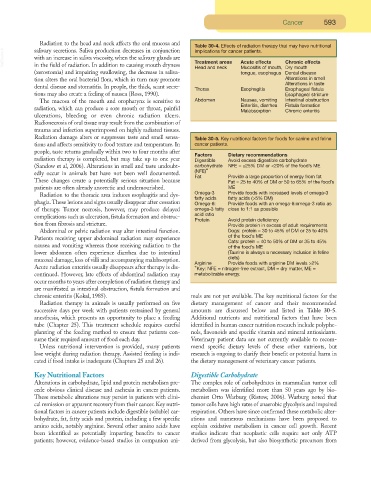Page 572 - Small Animal Clinical Nutrition 5th Edition
P. 572
Cancer 593
Radiation to the head and neck affects the oral mucosa and
Table 30-4. Effects of radiation therapy that may have nutritional
salivary secretions. Saliva production decreases in conjunction
VetBooks.ir with an increase in saliva viscosity, when the salivary glands are Treatment areas Acute effects Chronic effects
implications for cancer patients.
in the field of radiation. In addition to causing mouth dryness
(xerostomia) and impairing swallowing, the decrease in saliva- Head and neck Mucositis of mouth, Dry mouth
tongue, esophagus Dental disease
tion alters the oral bacterial flora, which in turn may promote Alterations in smell
Alterations in taste
dental disease and stomatitis. In people, the thick, scant secre-
Thorax Esophagitis Esophageal fistula
tions may also create a feeling of nausea (Ross, 1990). Esophageal stricture
The mucosa of the mouth and oropharynx is sensitive to Abdomen Nausea, vomiting Intestinal obstruction
Enteritis, diarrhea Fistula formation
radiation, which can produce a sore mouth or throat, painful
Malabsorption Chronic enteritis
ulcerations, bleeding or even chronic radiation ulcers.
Radionecrosis of oral tissue may result from the combination of
trauma and infection superimposed on highly radiated tissues.
Radiation damage alters or suppresses taste and smell sensa- Table 30-5. Key nutritional factors for foods for canine and feline
tions and affects sensitivity to food texture and temperature. In cancer patients.
people, taste returns gradually within two to four months after
Factors Dietary recommendations
radiation therapy is completed, but may take up to one year Digestible Avoid excess digestible carbohydrate
(Sandow et al, 2006). Alterations in smell and taste undoubt- carbohydrate NFE = ≤25% DM or <20% of the food’s ME
(NFE)*
edly occur in animals but have not been well documented.
Fat Provide a large proportion of energy from fat
These changes create a potentially serious situation because Fat = 25 to 40% of DM or 50 to 65% of the food’s
patients are often already anorectic and undernourished. ME
Radiation to the thoracic area induces esophagitis and dys- Omega-3 Provide foods with increased levels of omega-3
fatty acids fatty acids (>5% DM)
phagia.These lesions and signs usually disappear after cessation Omega-6: Provide foods with an omega-6:omega-3 ratio as
of therapy. Tumor necrosis, however, may produce delayed omega-3 fatty close to 1:1 as possible
complications such as ulceration, fistula formation and obstruc- acid ratio
Protein Avoid protein deficiency
tion from fibrosis and stricture. Provide protein in excess of adult requirements
Abdominal or pelvic radiation may alter intestinal function. Dogs: protein = 30 to 45% of DM or 25 to 40%
Patients receiving upper abdominal radiation may experience of the food’s ME
Cats: protein = 40 to 50% of DM or 35 to 45%
nausea and vomiting whereas those receiving radiation to the of the food’s ME
lower abdomen often experience diarrhea due to intestinal (Taurine is always a necessary inclusion in feline
mucosal damage, loss of villi and accompanying malabsorption. diets)
Arginine Provide foods with arginine DM levels >2%
Acute radiation enteritis usually disappears after therapy is dis- *Key: NFE = nitrogen-free extract, DM = dry matter, ME =
continued. However, late effects of abdominal radiation may metabolizable energy.
occur months to years after completion of radiation therapy and
are manifested as intestinal obstruction, fistula formation and
chronic enteritis (Kokal, 1985). mals are not yet available. The key nutritional factors for the
Radiation therapy in animals is usually performed on five dietary management of cancer and their recommended
successive days per week with patients restrained by general amounts are discussed below and listed in Table 30-5.
anesthesia, which presents an opportunity to place a feeding Additional nutrients and nutritional factors that have been
tube (Chapter 25). This treatment schedule requires careful identified in human cancer nutrition research include polyphe-
planning of the feeding method to ensure that patients con- nols, flavonoids and specific vitamin and mineral antioxidants.
sume their required amount of food each day. Veterinary patient data are not currently available to recom-
Unless nutritional intervention is provided, many patients mend specific dietary levels of these other nutrients, but
lose weight during radiation therapy. Assisted feeding is indi- research is ongoing to clarify their benefit or potential harm in
cated if food intake is inadequate (Chapters 25 and 26). the dietary management of veterinary cancer patients.
Key Nutritional Factors Digestible Carbohydrate
Alterations in carbohydrate, lipid and protein metabolism pre- The complex role of carbohydrates in mammalian tumor cell
cede obvious clinical disease and cachexia in cancer patients. metabolism was identified more than 50 years ago by bio-
These metabolic alterations may persist in patients with clini- chemist Otto Warburg (Ristow, 2006). Warburg noted that
cal remission or apparent recovery from their cancer. Key nutri- tumor cells have high rates of anaerobic glycolysis and impaired
tional factors in cancer patients include digestible (soluble) car- respiration. Others have since confirmed these metabolic alter-
bohydrate, fat, fatty acids and protein, including a few specific ations and numerous mechanisms have been proposed to
amino acids, notably arginine. Several other amino acids have explain oxidative metabolism in cancer cell growth. Recent
been identified as potentially imparting benefits to cancer studies indicate that neoplastic cells require not only ATP
patients; however, evidence-based studies in companion ani- derived from glycolysis, but also biosynthetic precursors from

